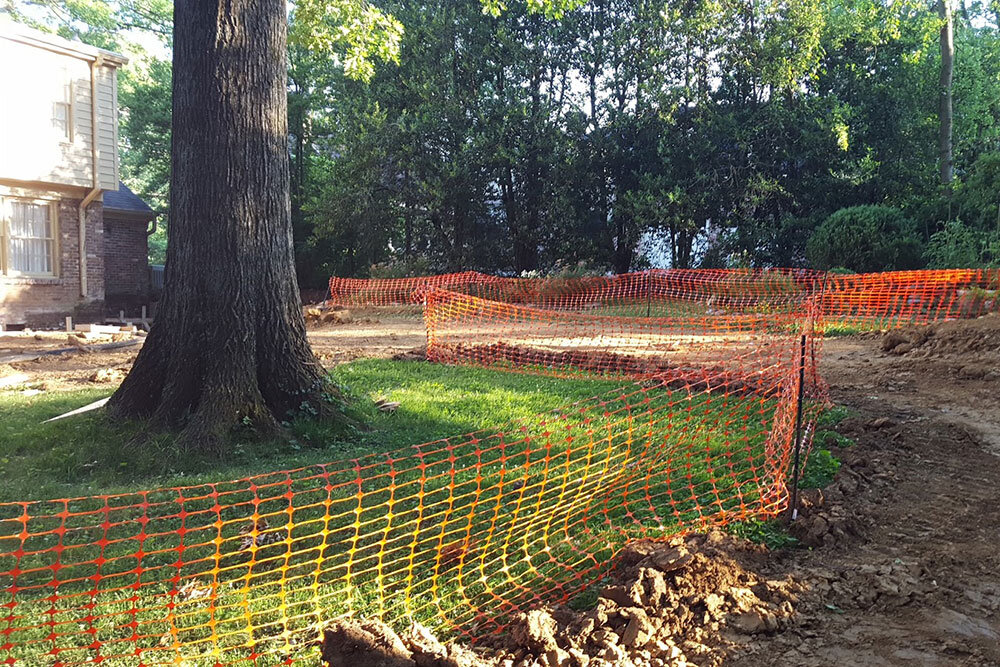Protective Fencing Is Essential for Trees During Construction
What Are the Benefits of Protective Fencing?
Protecting Trees During Construction
Protective fencing can be critical to a tree’s health during construction and development projects. Whether the work is being done by a homeowner or a contractor, tree protection must be incorporated into the planning of a project before it begins to limit the damage to trees.
According to Michael Davie, NTCC board member and master arborist with Bartlett Tree Care, the main risk comes from disturbing the soil beneath a tree and its root system. He says appropriate protective fencing and communication with everyone involved in the project is the easiest way to achieve minimal disturbance.
Maintain the Soil
Established root systems can be damaged by digging for drainage lines or utility connections like electric, gas, water and sewers. When a tree’s roots are disturbed (such as being cut or compacted under soil), it will lose some of the ability to pull in moisture, nutrients and air to nourish the rest of the plant and perform its functions. If the root damage is close enough to the trunk, it can damage the tree’s anchorage in the ground.
Leveling off land for a flatter surface, if trees are left during this process, is also a sure way to damage roots, which are often close to the soil surface. A lot of roots can be lost if the soil is scraped flat. Additionally, soil is often moved during construction, then replaced. If the roots are re-buried too deeply, they can be suffocated with too much soil and not enough access to water and air.
Suffocation of root systems can also happen when soil is compacted by heavy machinery that drives over them or when construction materials are piled up beneath trees. When drainage patterns aren’t taken into account, roots can be drowned by runoff from the building, from rain gutters or from other impermeable services redirecting the water. Soil can also be eroded this way, another risk to a tree’s roots, stability and health.
A Tree’s Drip Line
Michael gives his advice on constructing or renovating buildings: “When deciding how to fence off a tree for a project, consider the size of the root system. It’s ideal to maximize the areas protected around the tree.” He suggests using the tree’s drip line as a rule of thumb for how far out the roots extend. This is the area of ground under the edge of the canopy’s reach; in other words, where the outer leaves of a tree drip runoff onto the ground. Michael notes, however, that roots will almost always go past the drip line. This should be considered the minimum area to protect around a tree.
Setting Up the Fence
Michael recommends using sturdy protective fencing any time there is invasive activity near a tree, with plenty of signage and communication from the beginning. “Even if the contractor knows to stay away from the trees, there are so many people coming and going during construction,” he says. “The message can easily be lost over the many steps that a project has, and there may be no one to tell someone to stop.” The sturdier the fencing, the better; chain link fencing or panels are less likely to be moved or damaged.
Planning ahead, using solid materials and maintaining communication throughout the project can be the best strategy to maintain a tree’s health. When a root system is damaged, it might not show for a couple of years, followed by several years of decline, but sometimes the injury is so bad that it affects the tree immediately. Michael shared a story about a time when this happened: “the customer loved trees and wanted to protect them, and put up fencing when a water line was being installed. Someone on the construction team moved the fencing, dug next to the tree, and killed it.” This illustrates how even when a homeowner is aware of the risks, there can be difficulty protecting a tree during construction.
The Nashville Tree Conservation Corps shares these stories and information with you because people who appreciate the importance of trees in our yards and our parks can all be active stewards of Nashville’s tree canopy. You can subscribe to our email to stay updated on best practices and our activities!


